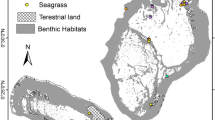Abstract
Coral reefs are important because of their high biodiversity and their key role in the tropical marine biosphere. Furthermore, coral reefs are very valuable as a socioeconomic resource as they make important contributions to the gross domestic product of many countries. Thus, it is very important to monitor dynamic spatial distributions of coral reefs and related habitats dominated by coral rubble, dead coral, and bleached corals. Despite these natural and socio-economic advantages, many factors are threatening coral reefs. The study site was selected in Spermonde archipelago, South Sulawesi, Indonesia because this area is included in the Coral Triangle, recognized as the epicenter of coral diversity and a priority for conservation. Images of Landsat MSS, Landsat TM, Landsat ETM, Landsat ETM+, and Landsat 8 data were used to examine changes in the coral reefs of Suranti Island in the Spermonde Archipelago during forty one years from 1972 to 2013. The image processing includes gap fills, atmospheric corrections, geometric corrections, image composites, water column corrections, unsupervised classifications, and reclassifications. Fill Gap processing was done on Landsat ETM+ SLC-off. Subsequently, a multi-component change detection procedure was applied to define changes. Shallow water bottom types classification was divided into live coral, rubble and sand habitats, dead coral with algae, rubble, and sand. Preliminary results showed significant changes during the period 1972–2013 as well as changes in coral reefs, likely explained partly by destructive fishing practices.
Similar content being viewed by others
References
Andréfouët S, Guzman HM (2005) Coral reef distribution, status and geomorphology-biodiversity relationship in Kuna Yala (San Blas) archipelago, Caribbean Panama. Coral Reefs 24:31–42
Andréfouët S, Kramer P, Torres-Pulliza D, Joyce KE, Hochberg EJ, Garza-Pérezf R, Mumbyg PJ, Rieglh B, Yamanoi H, Whitej WH, Zubiak M, Brockc JC, Phinnd SR, Naseerl A, Hatcherl BG, Muller-Karger FE (2003) Multi-site evaluation of IKONOS data for classification of tropical coral reef environments. Remote Sens Environ 88:128–143
Barnes BB, Hu C, Holekamp KL, Blonski S, Spiering BA, Palandro D, Lapointe B (2014) Use of Landsat data to track historical water quality changes in Florida Keys marine environments. Remote Sens Environ 140: 485–496
Botha EJ, Brando VE, Anstee JM, Dekker AG, Sagar S (2013) Increased spectral resolution enhances coral detection under varying water conditions. Remote Sens Environ 131: 247–261
Chavez PS (1988) An improved dark-object subtraction technique for atmospheric scattering correction of multispectral data. Remote Sens Environ 24:459–479
Contreras-Silva AI, Lopez-Caloca AA, Tapia-Silva FO, Cerdeira-Estrada S (2012) Satellite remote sensing of coral reef habitats mapping in shallow waters at banco chinchorro reefs, México: a classification approach. In: Escalante-Ramirez B (ed) Remote Sensing — Applications. Intech, Mexico, pp 331–354
Coral Reef Rehabilitation and Management Project (2010) Final Report: data base of Coral Reef Status in South Sulawesi. Makassar (ID) Coremap II dan Dinas Kelautan dan Perikanan Provinsi Sulawesi Selatan.
Elvidge CD, Dietz JB, Berkelmans R, Andréfouët S, Skirving W, Strong AE, Tuttle BT (2004) Satellite observation of Keppel Islands (Great Barrier Reef) 2002 coral bleaching using IKONOS data. Coral Reefs 23:123–132
English S, Wilkinson C, Baker V (1997) Survey manual for tropical marine resources, 2nd edn. Australian Institute of Marine Science, Townsville, 390 p
Foody GM, Campbell NA, Trodd NM, Wood TF (1992) Derivation and applications of probabilistic measures of class membership from the maximum-likelihood classification. Photogramm Eng Rem S 58(58):1335–1341
Gomez ED, Yap HT (1988) Monitoring reef condition. In: Kenchington RA, Hudson BET (eds) Coral reef management hand book. UNESCO Regional Office for Science and Technology for South East Asia, Jakarta, pp 171–178
Green EP, Mumby PJ, Edwards AJ, Clark CD (1996) A review of remote sensing for the assessment and management of tropical coastal resources. Coast Manage 24:1–40
Knudby A, Jupiter S, Roelfsema C, Lyons M, Phinn S (2013) Mapping coral reef resilience indicators using field and remotely sensed data. Remote Sens 5(5):1311–1334
Kotta J, Kutser T, Teeveer K, Vahtmäe E, Pärnoja M (2013) Predicting species cover of marine macrophyte and invertebrate species combining hyperspectral remote sensing, machine learning and regression techniques. PLoS ONE 8(8):e63946
Lyzenga DR (1978) Passive remote sensing techniques for mapping water depth and bottom features. Appl Optics 17:379–383
Mishra DR, Narumalani S, Rundquist D, Lawson M (2006) Benthic habitat mapping in tropical marine environments using Quickbird multispectral data. Photogramm Eng Rem S 72:1037–1048
Palandro D, Andrefouet S, Hu C, Hallock P, Müller-Kargera FE, Dustan P, Callahan MK, Kranenburg C, Beaver CR (2008) Quantification of two decades of coral reef habitat decline in the Florida Keys National Marine Sanctuary using Landsat data (1984–2002). Remote Sens Environ 112:3388–3399
Riegl BM, Purkis SJ (2005) Detection of shallow subtidal corals from IKONOS satellite and QTC View (50, 200 kHz) singlebeam sonar data (Arabian Gulf; Dubai, UAE). Remote Sens Environ 95:96–114
Torres-Pulliza D, Wilson JR, Darmawan A, Campbell SJ, Andréfouë S (2013) Ecoregional scale seagrass mapping: a tool to support resilient MPA network design in the coral triangle. Ocean Coast Manage 80:55–64
Yusuf S, Jompa J (2012) Indonesia First Quantitative Assessment of Coral Bleaching on Indonesian Reefs. In: Proceedings of the 12th International Coral Reef Symposium. Cairns, Australia 9–13 July 2012
Veron JEN, De Vantier LM, Turak E, Green AL, Kininmonth S, Stafford-Smith M, Petersen N (2009) Delineating the Coral Triangle. Galaxea J Coral Reef Stud 11:91–100
Author information
Authors and Affiliations
Corresponding author
Rights and permissions
About this article
Cite this article
Nurdin, N., Komatsu, T., Agus et al. Multisensor and multitemporal data from Landsat images to detect damage to coral reefs, small islands in the Spermonde archipelago, Indonesia. Ocean Sci. J. 50, 317–325 (2015). https://doi.org/10.1007/s12601-015-0029-x
Received:
Revised:
Accepted:
Published:
Issue Date:
DOI: https://doi.org/10.1007/s12601-015-0029-x




